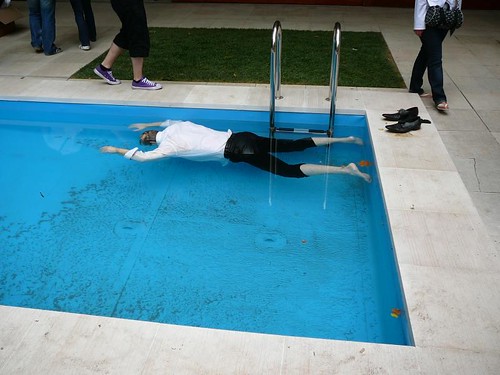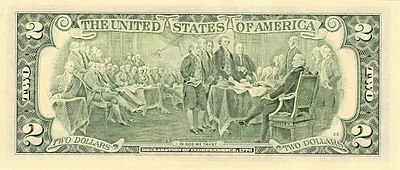Show Highlight
The Collectors - in the Danish and Nordic Pavilion
Don't Miss
The huts at the back of the Arsenale - hard to find but worth the trouble.
The Ukraine pavilion - kitchy and fun.
AES+F's video The Feast of Trimalchio in Unconditional Love at Arsenale Novissimo (take the free shuttle ferry at the end of the Arsenale).
The question on many minds at the 2009 Venice B was how the director Daniel Birnbaum would perform. Birnbaum accepted the appointed in April 2008, and some undoubtedly felt sympathy for the new director, who took charge under tempestuous circumstance, with only 14 months to organize the mammoth event.
Robert Storr had been commissioned to direct both the 2007 and 2009 Venice Biennale, but after a clash with the organizers, he pulled out of this years show, leading to a scramble. For my part, I was saddened we didn't see Robert Storr's part deux. It would have been fascinating to compare a before-crash 2007 Biennale with an after-crash 2009 Biennale directed by the same person... How would Storr have reflected this change? We will never know.
Did Birnbaum succeed? In my opinion the answer is yes. At the Arsenale and the Italian Pavilion in the Giardini (now renamed the Palazzo delle Esposizioni), Birnbaum started with large-scale and bold installations - by Lygia Pape, Michelangelo Pistoletto, Wade Guyton/Kelley Walker, Tomas Saraceno, and Massimo Barteloni. These giant works set the tone for much of what was to follow - a focus on aesthetic play and use of space, a deflection of any obvious political readings, and a mixture of old as well as new. Lygia Pape, who died in 2004, was one of 13 dead artists in the 90-artist exhibition, an unusually high percentage for a contemporary art show. It was a bold start.

Installation by Lygia Pape, from artnet.
Birnbaum has drunk the koolaid of pluralism, and his show reflected a diverse range of interests. Still, there was less of the political gravitas and shock factor of Storr's show - no videos of human skulls being used as footballs, for example - and virtually no grand abstract painting - no Gerhard Richter's this time. The tone of much of the curated exhibition was light and humorous, though without sacrificing substance.
In the national pavilions, there has been much chatter about Liam Gillick, a British artist, installed as the sole occupant of the German pavilion. Some saw this as a call for the end of nationhood - the national pavilions have long been viewed as anarchonistic. But putting a white male British artist in the German pavilion felt tame to me - this move does very little to undermine national sovereignty.
 ELMGREEN & DRAGSET "death of a collector" @La Biennale 2009, Photo by Strifu
ELMGREEN & DRAGSET "death of a collector" @La Biennale 2009, Photo by Strifu
Instead of Gillian's taxidermied cat in the German pavilion, I was more drawn to Maurizio Cattelan's taxidermied dog, part of The Collectors, a joint collaboration between the Danish and Nordic Pavilions, organized by the artists Michael Elmgreen & Ingar Dragset (photos here or here). The dog is listening to its master's voice - a groaning modernist sculpture, both comical and eerie. The Collectors was for me the strongest statement in the Biennale, even to the extent of upstaging Birnbaum's giant show. It represented a complex collaborative model between nations and individuals. It was less straightforward than the blunt bi-nationalism proposed in Germany's pavilion. The entrance signaled what was in store - a real estate "For Sale" sign was cockily planted in front of the Danish pavilion (apparently, you can book an appointment for a tour with an estate agent). Inside the pavilions, Elmgreen & Dragset had "staged" over twenty artists - meaning that some elements of the show were artworks and others were set dressing. Was the poster near the entrance an artwork? You decide.
The Collectors had a didactic narrative element. The two pavilions represented the homes of two fictional art collectors. In front of the Nordic pavilion, a swimming pool held a floating mannequin representing the owner, a writer who had committed suicide. Visitors were invited to lie on the bed, sit in the chairs and otherwise occupy the house, introducing a participatory element. The artworks themselves were solid, unashamedly homo-erotic, with modernist trappings.
What are we to make of this multi-layered bending of public and private, national, collaborative, staging and art? The Collectors operated on different levels, and I felt compelled to return to it on a second day. The revisit did not disappoint. I saw that on one hand the show could be read as the death of collectors - a symbol perhaps of the collapse of the art market. But it could also be seen as the death of curating.

David Bestué / Marc Vives
Finally, among my favorites in the international exhibition were the videos by David Bestué / Marc Vives. One video showed a horse transforming into a person into a super-hero, all done using costume parts that folded and collapsed. It was a rickety and hilarious. It is hard to find - set at the tail end, in one of the collapsing sheds at the very back of the Arsenale, the video was the opposite of the grand start, and the perfect endnote.











